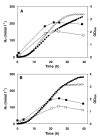Efficient hydrogen production from the lignocellulosic energy crop Miscanthus by the extreme thermophilic bacteria Caldicellulosiruptor saccharolyticus and Thermotoga neapolitana
- PMID: 19534765
- PMCID: PMC2701949
- DOI: 10.1186/1754-6834-2-12
Efficient hydrogen production from the lignocellulosic energy crop Miscanthus by the extreme thermophilic bacteria Caldicellulosiruptor saccharolyticus and Thermotoga neapolitana
Abstract
Background: The production of hydrogen from biomass by fermentation is one of the routes that can contribute to a future sustainable hydrogen economy. Lignocellulosic biomass is an attractive feedstock because of its abundance, low production costs and high polysaccharide content.
Results: Batch cultures of Caldicellulosiruptor saccharolyticus and Thermotoga neapolitana produced hydrogen, carbon dioxide and acetic acid as the main products from soluble saccharides in Miscanthus hydrolysate. The presence of fermentation inhibitors, such as furfural and 5-hydroxylmethyl furfural, in this lignocellulosic hydrolysate was avoided by the mild alkaline-pretreatment conditions at a low temperature of 75 degrees C. Both microorganisms simultaneously and completely utilized all pentoses, hexoses and oligomeric saccharides up to a total concentration of 17 g l-1 in pH-controlled batch cultures. T. neapolitana showed a preference for glucose over xylose, which are the main sugars in the hydrolysate. Hydrogen yields of 2.9 to 3.4 mol H2 per mol of hexose, corresponding to 74 to 85% of the theoretical yield, were obtained in these batch fermentations. The yields were higher with cultures of C. saccharolyticus compared to T. neapolitana. In contrast, the rate of substrate consumption and hydrogen production was higher with T. neapolitana. At substrate concentrations exceeding 30 g l-1, sugar consumption was incomplete, and lower hydrogen yields of 2.0 to 2.4 mol per mol of consumed hexose were obtained.
Conclusion: Efficient hydrogen production in combination with simultaneous and complete utilization of all saccharides has been obtained during the growth of thermophilic bacteria on hydrolysate of the lignocellulosic feedstock Miscanthus. The use of thermophilic bacteria will therefore significantly contribute to the energy efficiency of a bioprocess for hydrogen production from biomass.
Figures






References
-
- Li C, Fang HH. Fermentative hydrogen production from wastewater and solid wastes by mixed cultures. Crit Rev Environ Sci Technol. 2007;37:1–39.
-
- Saratale GD, Chen S-D, Lo Y-C, Saratale RG, Chang J-S. Outlook of biohydrogen production from lignocellulosic feedstock using dark fermentation – a review. J Sci Ind Res. 2008;67:962–979.
-
- Valdez-Vazquez I, Sparling R, Risbey D, Rinderknecht-Seijas N, Poggi-Varaldo M. Hydrogen generation via anaerobic fermentation of paper mill wastes. Bioresour Technol . 2005;96:1907–1913. - PubMed
-
- Fan Y-T, Zhang Y-H, Zhang S-F, Hou H-W, Ren B-Z. Efficient conversion of wheat straw wastes into biohydrogen gas by cow dung compost. Bioresour Technol. 2006;97:500–505. - PubMed
-
- Levin DB, Islam R, Cicek N, Sparling R. Hydrogen production by Clostridium thermocellum 27405 from cellulosic biomass substrates. Int J Hydrogen Energy. 2006;31:1496–1503.
LinkOut - more resources
Full Text Sources
Other Literature Sources
Molecular Biology Databases

